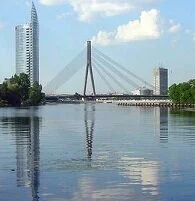Architecture of Latvia

Modern Riga
From an architectural standpoint, the first and last stop to make is Latvia's capital of Riga. Much of the village or rural architecture was constructed from wood so most of the structures in the countryside today are fairly modern. Riga, however was an influential and powerful city for hundreds of years, particularly as a Hanseatic League city and today as the country's capital, leading to great wealth and construction.
Riga's prosperity began in the 1200s when the city, which has access to the Baltic Sea, joined the Hanseatic League. From this point until the 1400s the city prospered and much of the town's historic district is in the style of the time, primarily Gothic, leaning towards the German variety.

Art Nouveau in Riga
Little still standing construction was built from the 1500s to the 1700s, but in the 1800s the city again grew to prosperity as a trading city. It was during this time that the city again expanded, primarily in the neo-Classical, then in the Art Nouveau style. The city was so prosperous and adopted the Art Nouveau style to such a degree that many consider the city the best example of Art Nouveau in the world.